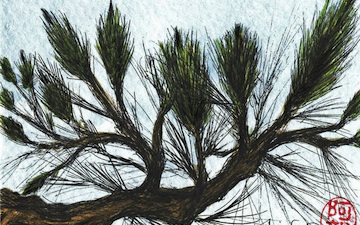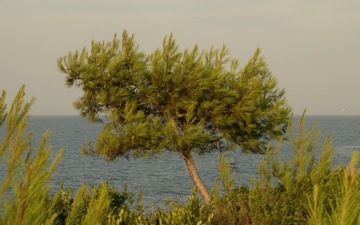Pinus halepensis, commonly known as the Aleppo Pine, is a pine native to the Mediterranean region. Their range extends from Morocco and Spain north to southern France, Italy and Croatia, and east to Greece and northern Tunisia, and Libya, with an outlying population (from which it was first described) in Syria, Lebanon, southern Turkey, Jordan, Israel, and Palestinian territories, where it is known as the Jerusalem pine.[2]
Pinus halepensis, the Aleppo pine, is generally found at low altitudes, mostly from sea level to 200 metres (660 ft), but can grow at an altitude of up to 1,000 m (3,300 ft) in southern Spain, well over 1,200 m (3,900 ft) on Crete and up to 1,700 m (5,600 ft) in the south, in Morocco, Algeria and Tunisia.[3][4]
Pinus halepensis is a small to medium-size tree, 15–25 metres (49–82 ft) tall, with a trunk diameter of up to 60 centimetres (24 in), exceptionally up to 1 m (3 ft 3 in). The bark is orange-red, thick and deeply fissured at the base of the trunk, and thin and flaky in the upper crown. The leaves (“needles”) are very slender, 6–12 cm (2.4–4.7 in) long, distinctly yellowish green and produced in pairs (rarely a few in threes). The cones are narrow conic, 5–12 cm (2.0–4.7 in) long and 2–3 cm (0.79–1.2 in) broad at the base when closed, green at first, ripening glossy red-brown when 24 months old. They open slowly over the next few years, a process quickened if they are exposed to heat such as in forest fires. The cones open 5–8 cm (2.0–3.1 in) wide to allow the seeds to disperse. The seeds are 5–6 mm (0.20–0.24 in) long, with a 20 mm (0.79 in) wing, and are wind-dispersed.[3][4][5]
(From Wikipedia, 29 December 2011)
—
Aleppo Pine is closely related to the Turkish Pine, Canary Island Pine and Maritime Pine which all share many of its characteristics. Some authors include the Turkish Pine as a subspecies of the Aleppo Pine, as Pinus halepensis subsp. brutia (Ten.) Holmboe,[6] but it is usually regarded as a distinct species.[3][4][5][7] It is a relatively non-variable species, with its morphological characteristics staying constant over the entire range.[3]
The resin of the Aleppo Pine is used to flavor the Greek wine retsina.
The Pinus halepensis is widely planted for timber in its native area, being one of the most important trees in forestry in Algeria and Morocco.[5] In Israel, the Aleppo Pine has been very successful in Yatir Forest in the northern Negev, where foresters had not expected it to survive. Native Aleppo pine forests can also be found in the Carmel and Galilee regions.[2]
The Aleppo Pine is considered an invasive species in South Africa, and in South Australia, where a control program is in place on Eyre Peninsula.
Pinus halepensis is a popular ornamental tree, extensively planted in gardens, parks, and private and agency landscapes in hot dry areas such as Southern California, where the Aleppo Pine’s considerable heat and drought tolerance, fast growth, and aesthetic qualities, are highly valued.
Paul Cézanne had an Aleppo Pine in his garden at Aix-en-Provence; this tree was the inspiration and model for his painting, The Big Trees. As of 2005, the tree is still growing in Cézanne’s garden.[8]
(From EOL, 29 December 2011)





